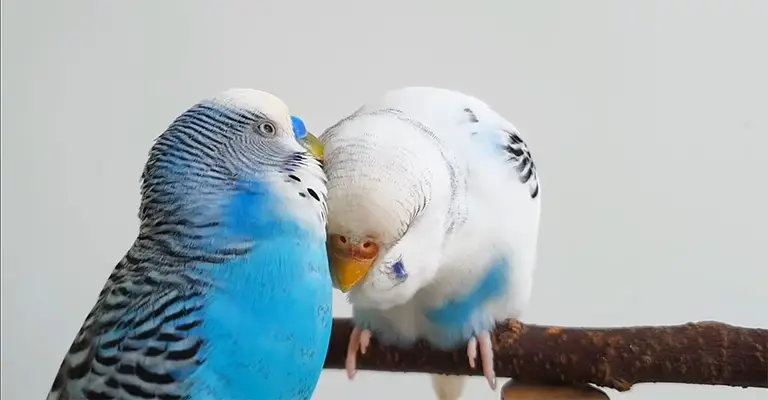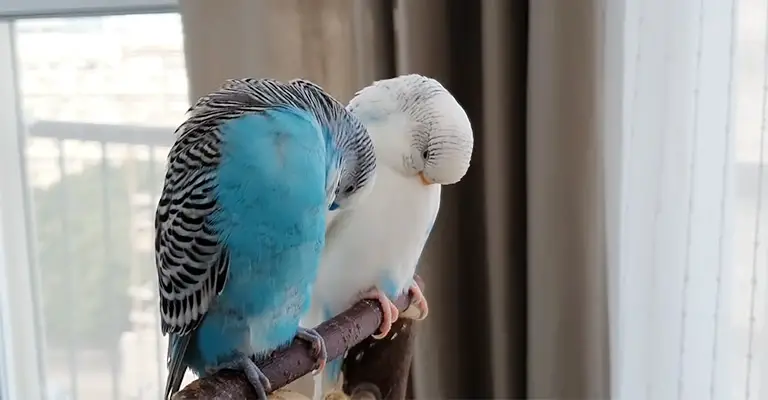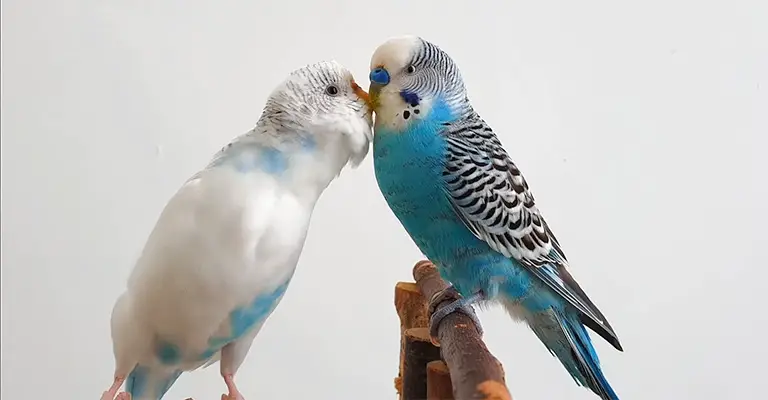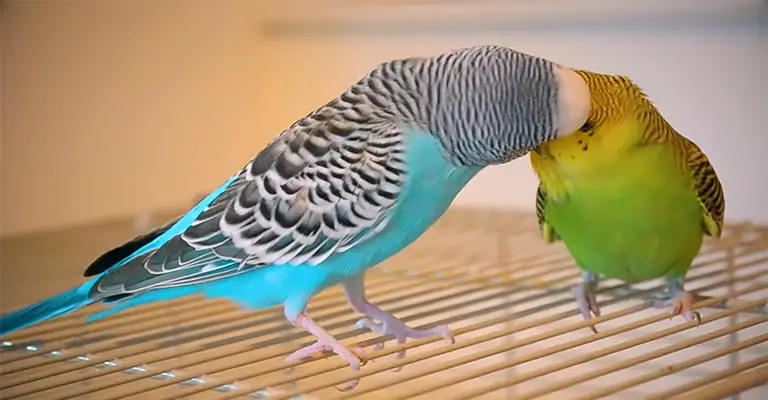Budgies, those charming and sociable feathered companions, are known for their ability to form deep bonds with each other and even with humans. These bonds go beyond mere cohabitation, revealing intricate connections that reflect the unique social nature of these birds.
As a budgie owner, deciphering the signs of a strong avian bond can be both heartwarming and essential to understanding their needs.
In this exploration, we delve into how to tell if budgies are bonded? Signs of a strong avian connection. From grooming rituals to shared activities, vocalizations, and even body language, these signs unveil the depth of their connections.
Your role as an observer and caretaker becomes more significant as you recognize the subtle cues that reveal these strong avian relationships.
By observing and recognizing these signals, you’ll gain insight into the intricate web of relationships that flourish within the vibrant world of budgies.

How to Tell If Budgies Are Bonded? Signs of a Strong Avian Connection
Let’s dive into the fascinating world of budgie relationships, uncovering the subtle cues that indicate a strong bond between these feathered friends.
Shared Activities and Interactions
Budgies that are bonded often engage in a variety of shared activities. These can include mutual grooming, where they gently preen each other’s feathers, as well as playful interactions like synchronized flights or games of chase.
Their willingness to spend time together in harmonious activities is a strong indicator of their close connection.
Vocalization Duets
Bonded budgies communicate with each other through an array of vocalizations. They engage in harmonious duets of chattering, soft warbles, and even synchronized calls. These vocal exchanges are a form of bonding and can convey a sense of unity and togetherness.
Physical Proximity
Budgies that share a strong bond often prefer to be in close physical proximity to each other. They might choose to perch side by side, sleep near each other, or even cuddle together. This physical closeness is a clear sign of their deep attachment.
Feeding Behaviors
Feeding each other is a common behavior in bonded budgies. This act of regurgitating food and offering it to their partner is a display of care and affection.
If you observe one budgie offering food to another and the recipient accepting it, you’re witnessing a strong bond in action.
Body Language and Comfort

Budgies that are bonded exhibit relaxed and content body language around each other. They might lower their wings, fluff up their feathers, and engage in gentle interactions without signs of aggression. This relaxed body language reflects the comfort they feel in each other’s presence.
Exclusive Interactions
Bonded budgies often prefer each other’s company over interactions with other budgies. They may engage in activities exclusively with their bonded partner, demonstrating a preference for that particular relationship.
Mirror Behavior
A fascinating aspect of bonded budgies is their mirror behavior. They might mimic each other’s actions, such as head bobs, calls, and even flights. This mirror behavior reinforces their strong connection and synchrony.
Protective Behavior
In bonded pairs, one budgie may exhibit protective behaviors towards the other. They might keep a watchful eye, perch nearby when their partner is resting, or even defend their partner from perceived threats.
Signs of Distress when Separated
Bonded budgies can become visibly distressed when separated from each other. They might chirp loudly, exhibit restlessness, or even show signs of anxiety. Reuniting them often results in visible relief and reassurance.
How Long Does It Take for Budgies to Bond with Each Other?

The time it takes for budgies to bond with each other can vary widely based on several factors, including the individual personalities of the budgies, their previous socialization experiences, and the environment in which they are introduced. Here are some factors to consider:
Individual Personalities
Just like humans, budgies have their own unique personalities. Some budgies are naturally more social and adaptable, making it easier for them to form bonds with new companions. Others might be more reserved or cautious, requiring more time to build trust.
Age and Background
The age and background of the budgies play a role in bonding. Young budgies might be more open to forming new bonds, while older budgies might be set in their ways and take longer to adjust to a new companion.
Budgies that have lived with other budgies before might be more accustomed to social interactions.
Socialization History
Budgies that have been raised with other budgies from a young age might be more accustomed to social interactions and could bond more quickly. Budgies that have been raised alone might take longer to adjust to a new companion.
Introduction Process
The way budgies are introduced to each other can impact the bonding process. Gradual introductions, where they can see and hear each other without direct contact, can help them get used to each other’s presence. Eventually, supervised face-to-face interactions can lead to bonding.
Environment and Cage Setup
A comfortable and spacious cage setup with multiple perches, toys, and feeding stations can facilitate bonding. Having enough space for each budgie to retreat if needed is important.
Observation and Patience
Observing the budgies’ interactions and body language is crucial. Some budgies might show signs of interest and curiosity early on, while others might need more time to warm up to the idea of a new companion.
Bonding timelines can range from a few days to several weeks or even months. It’s important to be patient and let the budgies establish their own pace. Rushing the process can lead to stress and setbacks.
Regular, supervised interactions, positive reinforcement, and a supportive environment can contribute to a successful bonding experience.
Keep in mind that not all budgies will necessarily become best friends. Some might develop a close bond, while others might simply tolerate each other’s presence. Respect their individual preferences and allow them to build their relationship in their own time.
How to Bond with Your Budgie?

Bonding with your budgie requires patience, consistency, and understanding. Building trust and forming a strong relationship takes time, but the efforts you invest will lead to a rewarding and enjoyable companionship. Here’s how to bond with your budgie:
Respect Their Space
Start by giving your budgie time to acclimate to their new environment. Place their cage in a quiet and calm area of your home where they can observe their surroundings without feeling overwhelmed.
Spend Time Near Them
Spend time sitting near your budgie’s cage and talking softly to them. This helps them become familiar with your presence and voice.
Offer Treats by Hand
Slowly introduce yourself by offering their favorite treats through the cage bars or on your open hand. Let them approach you at their own pace. Over time, they’ll associate your presence with positive experiences.
When you’re near your budgie, move slowly and avoid sudden or jerky movements that might startle them.
Use a Perch or Stick
Gradually extend your interactions by using a perch or stick to offer treats. This allows them to come closer to you while maintaining a sense of security.
Offer Safe Exploration
Allow your budgie to explore outside the cage in a secure and supervised area. This can help build their confidence and curiosity.
Talk and Sing
Budgies enjoy vocal interactions. Talk to them, sing, or play music softly. Your voice will become familiar and comforting to them.
Establish a routine for feeding, playtime, and social interactions. Budgies thrive on predictability and will become more comfortable with your presence over time.
Grooming and Comfort
Budgies may enjoy gentle preening or head scratches. Observe their body language to see if they’re comfortable with these interactions.
Remember that bonding takes time. Be patient and respect their boundaries. Don’t force interactions if your budgie seems stressed or fearful.
Offer Enrichment
Provide toys, perches, and activities that stimulate their minds and bodies. This encourages positive engagement with their environment.
Reward positive behaviors with treats or praise. This reinforces their trust in you and encourages desired interactions.
Training Sessions
Teaching your budgie simple tricks or commands through positive reinforcement training can strengthen your bond and engage their intellect.
As your budgie becomes more comfortable, they may initiate interactions by approaching you. Allow them to set the pace.
FAQs
The time it takes to bond with a budgie can vary widely. It might take a few weeks to several months, depending on the budgie’s personality, past experiences, and the effort you invest in building trust.
Yes, you can bond with an older budgie. While it might take more time for an older budgie to adjust to a new environment and build trust, patience, consistency, and positive interactions can help establish a strong bond.
If your budgie is initially afraid of you, start by giving them space and gradually introducing positive interactions. Offer treats, speak softly, and move slowly around them. Over time, they will likely become more comfortable.
Bonding with multiple budgies requires extra patience. Spend time interacting with each budgie individually and also provide opportunities for them to interact with each other under supervision.
Signs that your budgie is starting to bond with you include approaching you willingly, taking treats from your hand, chirping or chattering in response to your presence, and exhibiting relaxed body language when you’re nearby.
Parting Words
In the intricate tapestry of the avian world, the bonds that budgies form offer a glimpse into their complex and social nature.
As you embark on the journey of understanding and nurturing these connections, remember that each budgie’s personality contributes to the uniqueness of their relationships.
By recognizing the signs of a strong bond, you’re not only deepening your understanding of your feathered companions but also fostering an environment where their social needs are met.
The harmonious duets of chattering and soft murmurs convey emotions that words often struggle to capture.
Cherish the moments of shared activities, affectionate gestures, and harmonious vocalizations, for they are the threads that weave the fabric of your budgies’ relationships.
As you continue to observe, learn, and celebrate these signs, you’re embracing the rich tapestry of avian connection, enhancing the lives of your cherished budgies in the process.